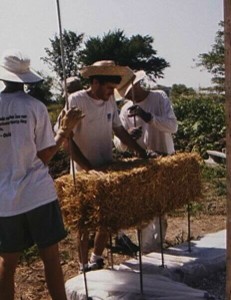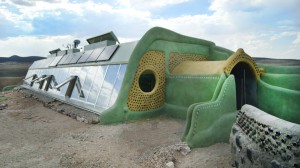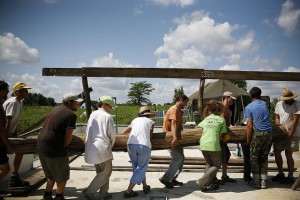
What’s the best way to build a sustainable home? As Lloyd Alter says, location matters most, so to begin, a sustainable home should be at an ecovillage like Dancing Rabbit, or anywhere that doesn’t rely on cars to get around. After that, what type of construction is most sustainable? Of course, it depends on the individual situation.
In Dancing Rabbit’s early days, we strongly considered Earthships as the best way to go. They are self-described as “radically sustainable”, a term DR has applied to itself from time to time. With a holistic approach incorporating energy use, water recycling, food growing, and low-impact building materials, they seemed perfect to address multiple sustainability issues at once.
The extensive reference materials seemed to be a blueprint for green housing (although we couldn’t afford the full construction drawing set, now selling for $3,500). We even considered flying Earthship’s founder out to coach us, but $1,000/day and paying for a first class plane ticket was beyond our modest means. Still, we spent a lot of time poring over the Earthship books and talking about pounding tires.
About that same time, strawbale construction was also starting to make the green building news, thanks to folks like Matts Myhrman and Stephen MacDonald, The Last Straw, and Out on Bale. In the summer of 1995 Tony Sirna and I built a strawbale chicken coop at Sandhill Farm – our first foray into strawbale construction. It seemed to go pretty well (although we hadn’t yet mastered the art of plastering – that would be several years, and umpteen coats of fallen-off plaster, later).

In the end, we settled on strawbale construction over Earthships. At least for our Missouri climate and soil, staying up above the clayey ground seemed the better choice, and straw was plentiful enough in our area.
Years later, two news articles remind me of that decision. One is that strawbale construction is in the next version of the international building code. As Andrew Morison puts it, this code “is the basis for the Residential Building Code in virtually every jurisdiction in the US. So once these jurisdictions adopt [the new code], there will be a straw bale code for almost every jurisdiction in the United States.” And it’s a small world – one of the big proponents of the code change was Dan Smith, who was the architect for Skyhouse. Congrats, Dan, and hopefully this code change will make building permitted strawbale buildings easier nationwide in the future.

The other reminder was a more critical piece by green building guru Martin Holladay, “Earthship Hype and Earthship Reality”. If you are interested in green building and don’t read Martin’s blog, you should, and this piece really gets into the details of Earthship construction, since apparently their sustainability claims set off Martin’s “E.A.S., or exaggeration alert system”. While there may be a place for Earthships in some circumstances, their cost and thermal performance issues make me glad that Dancing Rabbit focused in on strawbale in the end.
How long does a strawbale house last? I don’t know – all the ones I helped build are still standing, and others have been standing for over 100 years). Strawbale construction gives a good balance of affordability, beauty, thermal performance, air sealing (if plastered properly), local materials, and adaptability to a wide range of architectural styles. I can’t say it’s the best possible way to build, but if you want a green building and have straw in your area, you might consider it.

Cecil Scheib is Chief Program Officer at Urban Green Council in New York City. He is a founder of Dancing Rabbit Ecovillage and a member of its Board of Directors.
